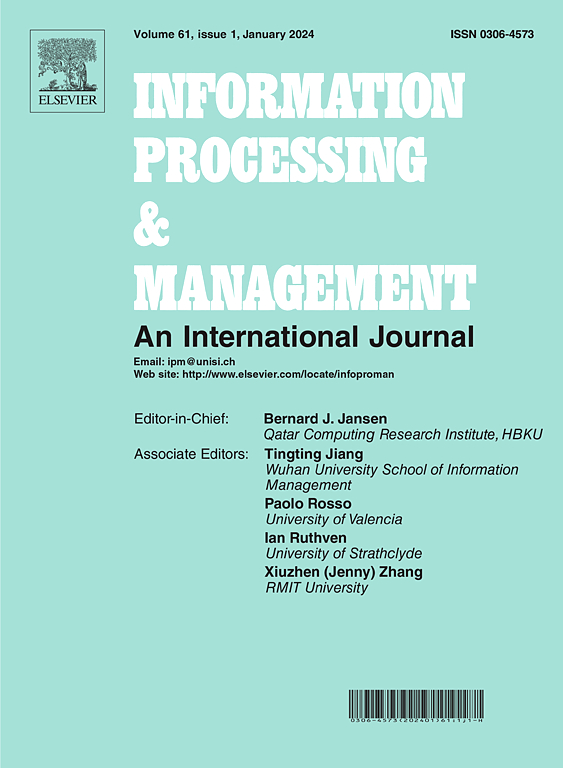用神经模型自动识别事实核查文章中的修辞动作和步骤
IF 7.4
1区 管理学
Q1 COMPUTER SCIENCE, INFORMATION SYSTEMS
引用次数: 0
摘要
由于网络上的错误信息引起了社会的关注,人们一直在努力进行事实核查,这有助于遏制错误信息的传播。其中,有说服力的事实核查文章发挥着基础作用,但很少有人关注它们的话语结构,而这对理解它们的运作方式很重要。修辞的动作和步骤是体裁分析中常见的,可以用来分析语篇结构和交际目的。在现有文献的基础上,本研究首先总结了事实核查文章的五步六步修辞结构,描述了事实核查文章如何组织以达到说服目的。然后,我们生成一个包含420篇文章的语料库,并对我们的结构进行注释。对于自动识别,我们提出了基于层次注意模型的BiLSTM,该模型在动作和步数上分别达到了70%和61.5%的微f1分数。性能和随后的烧蚀研究证明了我们模型的有效性。利用它,对3800篇事实核查文章的扩展集进行了移动和步骤的分布和模式分析。因此,我们发现文章中修辞结构的分布既有共同的特点,也有独特的差异,反映了写作时所使用的策略。我们进一步进行了序列挖掘,得到的频繁序列有助于提高事实核查写作水平,并为研究事实核查文本与其说服效果之间的关系提供了新的思路。一般来说,在这项工作中提出的事实核查修辞结构和自动化模型有可能帮助利用事实核查语料库,并最终有助于反驳错误信息。本文章由计算机程序翻译,如有差异,请以英文原文为准。
Automated rhetorical move and step recognition in fact-checking articles with neural models
As online misinformation has drawn social concerns, extensive efforts have been dedicated to fact-checking, which can help contain the spread of misinformation. Among them, persuasive fact-checking articles play a fundamental role, but little work has focused on their discourse structures that are important for understanding how they work. Rhetorical moves and steps, common in genre analysis, can be used to figure out text structures and communicative goals. Based on existing literature, this research first summarizes a rhetorical structure comprising five moves and six steps for fact-checking articles, which describes how they are organized to achieve the persuasive purpose. We then produce a corpus including 420 articles with annotations of our structures. For automated recognition, we propose our BiLSTM with Hierarchical Attention model, which achieves micro-F1 scores of 70 % and 61.5 % for moves and steps, respectively. The performance and subsequent ablation study demonstrate the effectiveness of our model. Utilizing it, an analysis of the distribution and patterns of moves and steps is conducted on an expanded set of 3800 fact-checking articles. Accordingly, we find that the distributions of rhetorical structures in articles have common characteristics and unique differences, reflecting the strategies used when writing. We further conducted sequence mining, and the obtained frequent sequences can help improve fact-checking writing and provide new ideas for studying the relationship between fact-checking texts and their persuasive effects. Generally, the fact-checking rhetorical structures and the automated model proposed in this work have the potential to help leverage the fact-checking corpus and finally contribute to rebutting misinformation.
求助全文
通过发布文献求助,成功后即可免费获取论文全文。
去求助
来源期刊

Information Processing & Management
工程技术-计算机:信息系统
CiteScore
17.00
自引率
11.60%
发文量
276
审稿时长
39 days
期刊介绍:
Information Processing and Management is dedicated to publishing cutting-edge original research at the convergence of computing and information science. Our scope encompasses theory, methods, and applications across various domains, including advertising, business, health, information science, information technology marketing, and social computing.
We aim to cater to the interests of both primary researchers and practitioners by offering an effective platform for the timely dissemination of advanced and topical issues in this interdisciplinary field. The journal places particular emphasis on original research articles, research survey articles, research method articles, and articles addressing critical applications of research. Join us in advancing knowledge and innovation at the intersection of computing and information science.
 求助内容:
求助内容: 应助结果提醒方式:
应助结果提醒方式:


